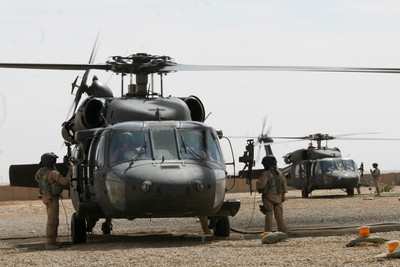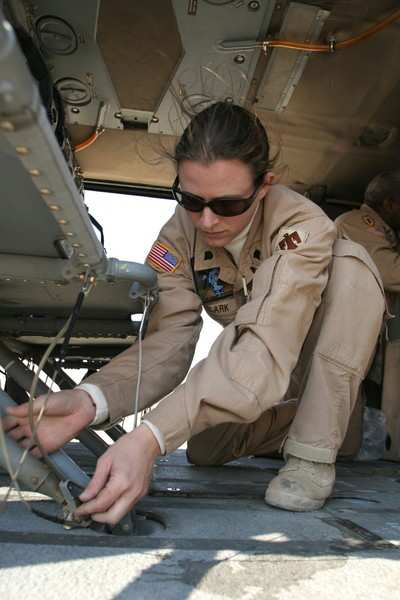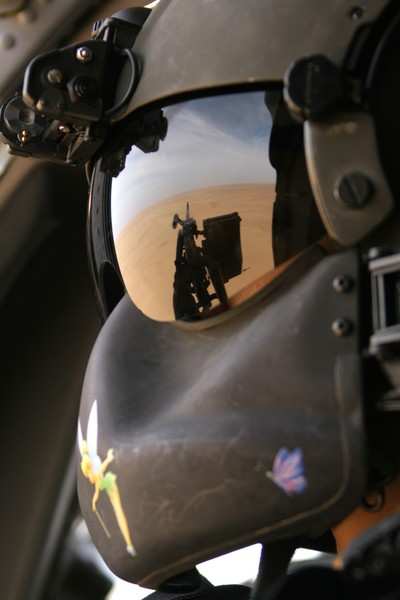 The tasking is constant,
and the daily flight schedule is packed with missions for one Army
helicopter squadron flying with the Marine Corps in Iraq. A group
of highly skilled pilots and crew chiefs are the reason for
success.
The tasking is constant,
and the daily flight schedule is packed with missions for one Army
helicopter squadron flying with the Marine Corps in Iraq. A group
of highly skilled pilots and crew chiefs are the reason for
success.
The Virginia Army National Guard's 2nd Battalion, 224th Aviation
Regiment, Marine Aircraft Group 16 (Reinforced), 3rd Marine
Aircraft Wing (Forward), Blackhawk crews are a unique asset for
Marine forces here, and these crews have been carrying out their
tasking for more than 10 months with exacting proficiency.
Planning and communication are the keys to successful missions
for UH-60 Blackhawk helicopter crews in Iraq, and both begin before
the aircraft engines are started on the ground.
“We’ll usually come in, get a brief on what mission
we’re doing, find out our destinations and where we’re
going,” said Chief Warrant Officer 3 Marvin R. McKenney, a
pilot with 2/224. “We also receive an intelligence brief of
any significant threats, anything going on that has
changed.”
Once the pilots receive the day’s mission and intelligence
briefs at their headquarters, one pilot goes with the crew chiefs
to prepare the helicopter for the mission, while the other plans
out the details of the mission ahead.
“One of the pilots will do the flight planning, which
includes the route planning, how long it will take to get there,
how much fuel is required and things like that,” said
McKenney, a Richmond, Va., native.

“At the same time, the other pilot is checking out the
aircraft with the crew chiefs.”
With their route planned and the aircraft inspected and ready to
go, the air crew gets together for a last set of briefs.
“We’ll do our individual briefs, one for the stick
(a two-aircraft section). Then, we’ll brief with our
aircraft’s crew,” said Staff Sgt. Troy G. Patterson,
Blackhawk crew chief and door gunner. “After that we’ll
get our weapons and ammo, conduct our combat checks and take off on
the mission.”

In the briefs just before takeoff, the crew reasserts the
importance of their continuous communication.
“There are a couple of things we brief every time before
we fly: advocacy and assertion,” said McKenney.
“Advocacy meaning, that if we’re flying along and
you’re not saying anything then it means you’re fine
with everything going on. Assertion meaning, if you're thinking
something’s wrong speak up and say so.”
While in flight, the Blackhawk air crews have separate
responsibilities as left and right side door gunners and pilot and
pilot-in-command. They use an internal communications system to
coordinate their actions in flight and most importantly, during
landings and takeoffs.

“The Army calls it aircrew coordination. In the civilian
sector, it’s cockpit resource management,” said
McKenney. “The Army adopted the CRM and renamed it ACC. What
it means is all the crewmembers have an equal say in what’s
going on. It encourages everybody to speak up if something’s
bothering them.”
“Both pilots do the same thing in flight. One has
pilot-in-control duties, and the other has the pilot-not-in-control
duties, which include the radios, navigation, and everything but
flying the aircraft,” said McKenney. “However, they
switch back and forth, and since there isn’t a lot of room up
front to move around, it gives the one flying a chance to stretch
because his feet are on the flight controls.”
With the pilot-in-control focusing on flying the aircraft, he
may not see a danger to the aircraft approaching, so the squadron
has a procedure in place to prevent any potential mishaps.

“We have the two challenge rule that the pilots use up
front,” said McKenney. “If I say, ‘hey do you see
that tree up front,’ and the other pilot doesn’t
answer, I say again ‘do you see that tree up front,’
and if he still doesn’t answer, then I am going to take the
controls so we avoid hitting it.”
Avoiding hitting deadly objects -- a task made more difficult by
potential blinding dust kicked up by the helicopters’ turning
blades -- is especially important when the helicopter is coming
into a landing zone, according to McKenney and Patterson.
“Before we even take off and during the crew brief,
we’re going to talk about some of the obstacles,” said
McKenney. “Once you go past 10 O-clock and 2 O-clock off the
nose of the aircraft, the crew chiefs are the pilot’s eyes
back there. We can’t see anything. When we’re coming
into the landing zone, the crew chiefs will call out the obstacles:
trees, stumps, rocks. Once we’re clear of the obstacles, one
of the crew chiefs will start calling out the dust cloud to let us
know that we need to find something inside the rotor disk
that’s not going to move, so we can land the
aircraft.”

“As a crew chief and door gunner, our primary job is
airspace surveillance and obstacle avoidance,” said
Patterson, a Chesapeake, Va., native. “We don’t want
anything to hit us, and we don’t want to hit anything. Of
course, we’re there for the protection of the crew,
passengers and aircraft, but it’s seldom that we are used as
an offensive weapon.”
One advantage the 2/224 has over other units operating in the Al
Anbar Province of Iraq, is the fact that many of the pilots and
crew chiefs have been flying together for years.
“We have a great relationship with the pilots,” said
Patterson. “We’re national guardsman, so we’ve
been flying with some of the same guys for more than ten
years.”
“I’ve been with a lot of these crew chiefs since I
started flying Blackhawks in 1996,” said McKenney.
“About 30 percent are new and all of them are hard workers
and really professional at their job.”
Despite being a tight-knit group and having a cutting edge
aircraft, Patterson credits the unit’s predeployment training
for their mission’s success.
“We had to adjust as crew chiefs in terms of the different
missions,” said Patterson. “Going through Exercise
Desert Talon in Yuma, Ariz., helped us out a lot. Any unit that is
coming out here, especially to work with the Marines should go. It
was an outstanding exercise. We learned a lot from it, especially
Marine Corps terminology. They use acronyms for everything. We use
them, too, but theirs are different. We built a really good
relationship with everybody we came out here with, while
there.”
With their deployment coming to a close soon, Patterson believes
their mission with the Marines has been a complete success thus
far.
“Our missions can be anything around here, especially with
the Blackhawks,” said Patterson. “It could be a
detainee lift, a raid or a VIP flight. That’s a result of the
aircraft being a medium-sized bird, and it has a ton of power for
its size. It’s dependable. I don’t think we’ve
ever been late and have only dropped one or two missions in ten
months.”

For McKenney, the deployment has been a summit for a long-time
flyer, challenging his skills and surprising him at times.
“When we first got out here, it was the most demanding
flying I’ve done in my life,” said McKenney. “The
first two months in country were purely night-vision goggle flying.
It definitely took time getting used to; I think all the pilots out
here would sing the praises of the heads up display inside the
goggles. It has everything that’s on the instrument panel
that I need to know. I learned to expect the unexpected. Dust
storms can pop up out of nowhere, and I was lucky to get caught up
in only one.” [ANN Salutes Cpl. Jonathan K. Teslevich, 3rd
Marine Aircraft Wing]
 ANN's Daily Aero-Linx (04.17.24)
ANN's Daily Aero-Linx (04.17.24) ANN's Daily Aero-Term (04.17.24): Jamming
ANN's Daily Aero-Term (04.17.24): Jamming ANN's Daily Aero-Linx (04.18.24)
ANN's Daily Aero-Linx (04.18.24) Aero-News: Quote of the Day (04.18.24)
Aero-News: Quote of the Day (04.18.24) ANN's Daily Aero-Term (04.18.24): Hold-In-Lieu Of Procedure Turn
ANN's Daily Aero-Term (04.18.24): Hold-In-Lieu Of Procedure Turn









